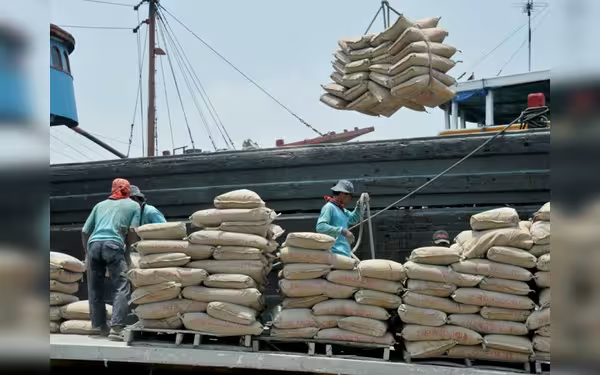Saturday, November 16, 2024 07:37 PM
Cement Industry Exports Surge Amid Domestic Challenges
- Cement exports reached one million tons in September 2024.
- DG Khan Cement targets new international markets.
- Domestic demand remains weak despite export growth.
 Image Credits: brecorder
Image Credits: brecorderThe cement industry in Pakistan sees a surge in exports, with DG Khan Cement targeting international markets despite domestic challenges.
The cement industry in Pakistan is currently experiencing a remarkable surge in its export activities, a development that is noteworthy given the challenges faced by other sectors, particularly textiles. This growth can be attributed to several factors, including the availability of cheaper coal, reduced import duties in neighboring markets like Sri Lanka, and an increasing acceptance of Pakistan-made cement in various international markets. Additionally, manufacturers are sitting on excess inventory due to sluggish domestic demand, prompting them to seek opportunities abroad.
In September 2024, cement exports approached a staggering one million tons, marking a 72 percent increase compared to the same month last year. Furthermore, during the first quarter of the fiscal year 2025, exports rose by 22 percent year on year. Notably, exports accounted for 28 percent of total cement sales in September 2024, a significant improvement over previous years. This trend indicates that the cement industry is not only surviving but thriving in a competitive global market.
One company leading the charge is DG Khan Cement Company (DGKC), which is actively pursuing new markets, including the United States. The company is navigating the complex qualification processes required to meet various international standards, particularly in key European countries like Germany and France. This strategic move is expected to yield positive results for DGKC, especially as domestic demand continues to lag behind expectations.
Looking ahead, the macroeconomic landscape in Pakistan remains uncertain, and cement companies must strive to maintain a balanced and profitable sales mix. While exports have shown promise, they are not without challenges. The industry faces stiff competition, with fluctuating commodity prices, port costs, and fuel prices impacting profitability. Moreover, domestic demand for cement is anticipated to remain weak in the coming months, despite some positive developments in the economic sector.
As major construction projects gradually resume, individual home buyers are feeling the pinch of higher taxes and inflation, making them more cautious about investing in new homes. The real estate sector is also facing difficulties, with many projects stalled and builders halting construction if they cannot secure enough sales to finance their developments. This situation leaves home buyers in a precarious position, often waiting long periods for their investments to materialize.
On the manufacturing side, cement producers are keen to maintain a healthy share of local sales, as this is where the majority of their profits lie. However, with local demand dwindling, manufacturers are increasingly looking to export clinker, cement, or both to international markets. This shift in focus is essential for the sustainability of the industry.
While the cement industry in Pakistan is currently enjoying a period of growth in exports, it must remain vigilant and adaptable to the ever-changing economic landscape. By exploring new markets and maintaining a balanced sales strategy, cement manufacturers can navigate the challenges ahead and continue to thrive. The resilience of this sector is a testament to the potential for growth, even in the face of adversity.













